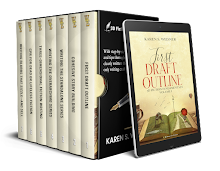{Put This One on Your TBR List}
Book Review: The
Starving Saints by Caitlin Starling
by Karen S. Wiesner

Beware spoilers lurking in a novel with more shadows than
were probably intended!
Wow, did I not know what to make of this dark, medieval fantasy novel, The Starving Saints, the newest (published May 20, 2025) from Caitlin Starling. This author is firmly on my to-buy list--and, in fact, I purchased the hardcover almost as soon as it came out. Even as I did it, I realized it was a risk, as I seem to react to Starling's books as either a ravenous fan or a reader irrevocably repulsed. Her novels The Luminous Dead and The Death of Jane Lawrence (both reviewed previously on this blog) are favorites of mine. That said, the stories I tend not to like by her are still uniquely, unmistakably Starling works. I'd want to read them, even if I ultimately hated them. Her handling of certain subject matters horrifies me…and probably not the way she would have preferred in this case. I'd have to put this particular novel firmly on the list of those by her that I didn't like. The reasons are as complex as the story itself. So let's get to it.
The basic story here is that Aymar Castle (set in a made up, medieval fantasy world) has been under siege for the past half a year. With food stores running low, hope dwindles, and desperation becomes the order of the day as there's seemingly no way out of this place. Then, out of nowhere (readers are never really told or made to understand how or definitively why), The Constant Lady and her three Saints (a twisted take on established religion that cruelly portrays bees--unequivocally summum bonum in the world of insects!--as villains) appear. The so-called divine offer sustenance and healing in exchange for adoration, but the price is far too high--at least for three main characters. Having a trio of points of view offered a 360-degree rendering of this dire situation. Whether or not these viewpoints are adequately well-drawn is, to my mind, a moot point.
Phosyne was a nun who's become a sorceress of sorts (no idea what brought that about). At the king's command, she somehow--even she doesn't know how she did it--turned fouled, toxic water into potable drink for the survivors. He's now tasked her with conjuring food out of nothing and nowhere, a known impossibility. But kings in any universe are always petulantly and imperiously demanding miracles of their underlings. That said, Phosyne wasn't a character to champion. In the latter half of the book, she speaks her true goal, and it's not pretty. Phosyne accuses the Lady of "playing with her food", and the evil deity shrugs off any guilt about seasoning her meat, keeping it occupied, and providing fertile fields for it to gorge itself. Soon Phosyne would understand the gratification of "having everything available to" her hungry teeth. It's at that point that this dubious heroine realizes she is hungry. "But it's not the hunger of an empty stomach. It's the need to taste. To chew. To consume. She wants to indulge." So, that's her angle in all its potentially ugly facets.
Ser Voyne is a knight, a war hero pledged to the Constant Lady as well as to her king, even if she doesn't exactly respect him. Voyne is trying to keep order over a place plunged into utter chaos. She has to decide whether following orders is wise when the leaders no longer know or are willing to do what's best for the people. As a character, Voyne is wishy-washy. When she finally answers the question about who to "worship" (because that's precisely how she loyally obeys), it's little more than transferring her disturbing adoration from one unworthy target to another.
Treila is a noble pretending to be a serving girl who refuses to admit to herself that she'd lusted after the big, beautiful knight who'd murdered her father. Now she longs for revenge. Or does she long for something far darker? Imagine someone willing to do anything, no matter how depraved, to survive. In Treila's world, it's literally eat or be eaten. And she's fully capable of doing whatever needs to be done to help herself. Not exactly noble or worth rooting for from my perspective.
All of these protagonists were weirdly complex and equally superficial. (Trust me, I think you'll understand that contradiction if you read the book.) One reviewer described the main characters' lack of development as "flip-flopping like a dying fish". True, we learned little more about them than what was necessary for the plot, a failure that struck me as sloppily convenient. That's just part of it though. None of these women were precisely good nor precisely evil--a complication that led to my lingering frustration over this book. If there's no one to root for, what's the purpose? Naturally, I couldn't champion the Lady or her saints--they were full-on evil. But the three heroines had agendas and motivations I didn't feel comfortable getting onboard with either. Starling's own definition of them as "complicated and sometimes terrible" was accurate. At least two of the protagonists were portrayed as selfish and abnormally self-serving while the knight seemed short-sighted and foolish with her blindly loyal veneration of unworthy beings.
Starling is noted for her lesbian fiction, which is generally well crafted. But the three-way attraction between these women came off as forced and far-fetched. There was nothing sexy or authentic about it. Again, why? What purpose did it serve to force them to ally when few compelling, let alone strong, connections actually bound them?
Unequivocally, The Starving Saints failed as the horror novel it was hailed as in everything I read about it. In an interview, the author said that she's a "big believer in limiting the narration of a story to what the characters perceive and comprehend, or don't. I keep my 'camera' very zoomed in." She asserts confidently that that enhances the horror. I found it did exactly the opposite. Not knowing what to be afraid of or to dread was my biggest disappointment with the story. Starling knows how to create atmosphere. She's effortlessly brilliant at it. However, as promising as this slow, plodding novel started out, the unnerving undertone quickly became mired in too many instances of dense fog. Should I have been horrified by the cannibalism (it was an unrestrained, gore-strewn, grotesque ick), the monsters (which ones were good or evil? who knows), the corrupt agendas of all, the shocking misuse of power by everyone who wielded it at various times as the story progressed? All hints at creepiness fizzled out because nothing came into focus clearly enough to scare the crap out of me--you know, my deepest longing when reading a horror novel. The author drowned readers with characters flagrantly telling, not really showing us, wild theories about all these hazy, shadowy things, but none were convincing enough to be presented as more than abstract methods of confusion. Ultimately, there was nothing scary, beyond that a writer would indulge in writing something like this without developing the plot and characters on a concrete foundation that helps ground readers from start of story to what I wanted to be a dazzling finish. (As to that, I didn't trust the hands left wielding all the power so it was the exact opposite of a happily ever after. But I guess those are no longer what readers are looking for.) In the end, it all came down to floundering for answers that were kept away--because the author herself didn't have any; hadn't even bothered crafting them. That stinks of laziness, not deliberate cleverness, to me.
Long years ago, I remember going on my first ever fantasy LARP quest before it became a big deal or was in any way well-done. No one on my team knew how to get started, what we should be doing, what was, frankly, going on. We spent a lot of time racing around, searching for clues that providing little more than added uncertainty, and looking at each other, expressing our confusion in these glances as well as in our increasingly frustrated words. That's what I felt like I was doing alongside fellow readers while reading The Starving Saint. Readers need, at the very least, veiled, skillful directions, just as LARPers (especially beginning ones) do. My LARP team members were all thinking, Do you know what's going on? What that's all about? Is it important? What is important? Who should we be rooting for? Is that the bad guy? What should be paying attention to? Where are all these unformed details going? Is there a purpose to this or anything? I never really found out the answers to any of these questions before closing The Starving Saints for the last time. I felt lost and unsatisfied for most of the disturbing events in this massacre of a story.
If I had to guess at the purpose of The Starving Saints, I'd throw out the nebulous theory that the author was playing with the ramifications of absolute power corrupting absolutely. Even someone who starts out altruistic will eventually fall to the hypnotizing lure and potential of power. But, as no one in this story qualified as a bona fide hero, that lesson didn't really come across. A wanna-be hero doesn't have far to fall themselves. There's little difference between them and the villain. Seems to me a waste not to set the stakes higher. But these days, it seems no one wants a hero in their fiction, something I'll probably never understand.
The setting itself was deliberately sketched to be obscure; on the whole, a bubble world set nowhere in particular to deflect attention from it. However, this isn't an insult. In this, I felt the lack of development fit the needs of the story. None of the characters in the castle realized the outside world no longer existed because the indeterminate antagonist(s) had enclosed it in a honeyed hive, where nothing could touch or steal its prize. In soft echo, I was harkened back to Poe's brilliant "The Masque of the Red Death" with this tale. To me, that was its saving grace.
A lot of minor things bugged me while reading this: 1) How often Starling fell into modern slang so out of place in a medieval setting, 2) how randomly and inconsistently the author used contractions, and 3) the use of cliffhanger chapters without adequate picking up of the threads once that particular point of view was revisited.
In the author's defense, (she tells us in the acknowledgements in the back of the book) she wrote the initial draft of this book during the COVID lockdown. She wrote it in a messy, out of order way--an attempt to mirror and/or sort out her anxiety. I remember the book I wrote myself during the lockdown--what I, to this day, call my COVID book. While I ended up really liking it, it's hard for me to read it now without concluding it was written a bit too perfectly. During that time, I was so hollow and unable to feel anything that layering emotion into the story was a brutally exacting exercise of my skill with the writing craft. Everything the story needed, it has, and yet I was distanced by my own experiences during that suffocating time. I know I'm not the only author who suffered deeply and yet didn't want to lose my heroic feats at continuing my profession during such a dry period. My publisher and I decided my efforts were worth releasing to the world, and, in that way, something good did come out of a terrible circumstance. I never envied other authors and publishers the task in trying to decide what was worth saving from that time for them either. If nothing else, Starling created something unique with The Starving Saints that leaves an indelible impression. If you're like me, you'll have to read it because she wrote it and it could be one of the best books ever written, though, unfortunately, I didn't find it to be worthwhile, as several others of hers are.
All this said, I'm still eagerly looking forward to Starling's brand new release, The Graceview Patient, (released October 14, 2025).
Karen Wiesner is an award-winning,
multi-genre author of over 150 titles and 16 series.
Visit her website and blog here: https://karenwiesner.weebly.com/
and https://karenwiesner.weebly.com/karens-quill-blog
Visit her publisher here: https://www.writers-exchange.com/Karen-Wiesner/





































